Jun-Yan Zhu
Learning an Image Editing Model without Image Editing Pairs
Oct 16, 2025Abstract:Recent image editing models have achieved impressive results while following natural language editing instructions, but they rely on supervised fine-tuning with large datasets of input-target pairs. This is a critical bottleneck, as such naturally occurring pairs are hard to curate at scale. Current workarounds use synthetic training pairs that leverage the zero-shot capabilities of existing models. However, this can propagate and magnify the artifacts of the pretrained model into the final trained model. In this work, we present a new training paradigm that eliminates the need for paired data entirely. Our approach directly optimizes a few-step diffusion model by unrolling it during training and leveraging feedback from vision-language models (VLMs). For each input and editing instruction, the VLM evaluates if an edit follows the instruction and preserves unchanged content, providing direct gradients for end-to-end optimization. To ensure visual fidelity, we incorporate distribution matching loss (DMD), which constrains generated images to remain within the image manifold learned by pretrained models. We evaluate our method on standard benchmarks and include an extensive ablation study. Without any paired data, our method performs on par with various image editing diffusion models trained on extensive supervised paired data, under the few-step setting. Given the same VLM as the reward model, we also outperform RL-based techniques like Flow-GRPO.
Prompt-to-Product: Generative Assembly via Bimanual Manipulation
Aug 28, 2025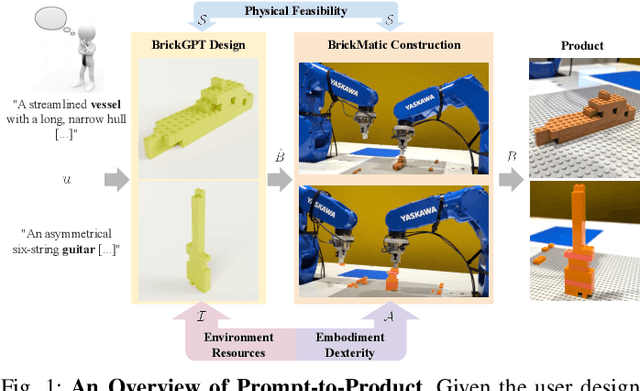
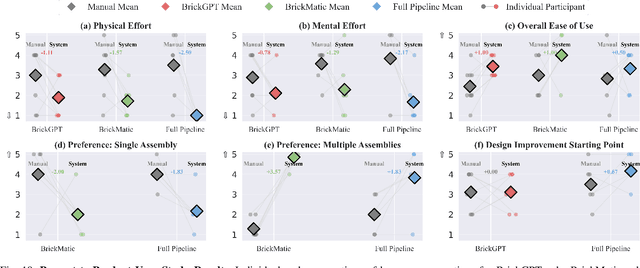
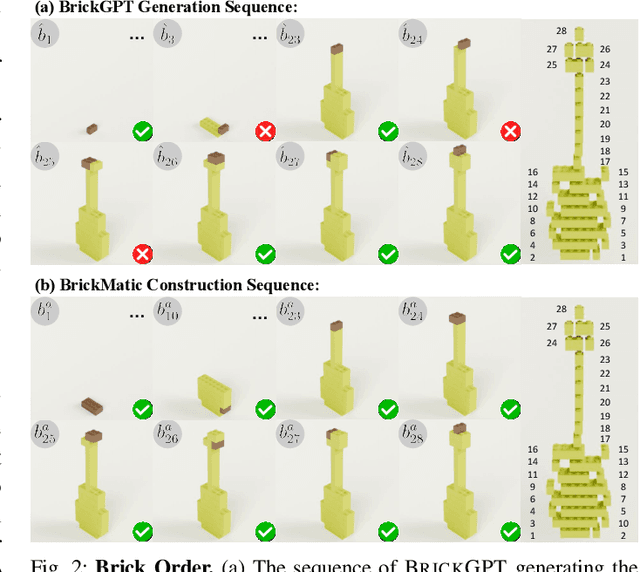

Abstract:Creating assembly products demands significant manual effort and expert knowledge in 1) designing the assembly and 2) constructing the product. This paper introduces Prompt-to-Product, an automated pipeline that generates real-world assembly products from natural language prompts. Specifically, we leverage LEGO bricks as the assembly platform and automate the process of creating brick assembly structures. Given the user design requirements, Prompt-to-Product generates physically buildable brick designs, and then leverages a bimanual robotic system to construct the real assembly products, bringing user imaginations into the real world. We conduct a comprehensive user study, and the results demonstrate that Prompt-to-Product significantly lowers the barrier and reduces manual effort in creating assembly products from imaginative ideas.
Scaling Group Inference for Diverse and High-Quality Generation
Aug 21, 2025Abstract:Generative models typically sample outputs independently, and recent inference-time guidance and scaling algorithms focus on improving the quality of individual samples. However, in real-world applications, users are often presented with a set of multiple images (e.g., 4-8) for each prompt, where independent sampling tends to lead to redundant results, limiting user choices and hindering idea exploration. In this work, we introduce a scalable group inference method that improves both the diversity and quality of a group of samples. We formulate group inference as a quadratic integer assignment problem: candidate outputs are modeled as graph nodes, and a subset is selected to optimize sample quality (unary term) while maximizing group diversity (binary term). To substantially improve runtime efficiency, we progressively prune the candidate set using intermediate predictions, allowing our method to scale up to large candidate sets. Extensive experiments show that our method significantly improves group diversity and quality compared to independent sampling baselines and recent inference algorithms. Our framework generalizes across a wide range of tasks, including text-to-image, image-to-image, image prompting, and video generation, enabling generative models to treat multiple outputs as cohesive groups rather than independent samples.
Identifying Prompted Artist Names from Generated Images
Jul 24, 2025Abstract:A common and controversial use of text-to-image models is to generate pictures by explicitly naming artists, such as "in the style of Greg Rutkowski". We introduce a benchmark for prompted-artist recognition: predicting which artist names were invoked in the prompt from the image alone. The dataset contains 1.95M images covering 110 artists and spans four generalization settings: held-out artists, increasing prompt complexity, multiple-artist prompts, and different text-to-image models. We evaluate feature similarity baselines, contrastive style descriptors, data attribution methods, supervised classifiers, and few-shot prototypical networks. Generalization patterns vary: supervised and few-shot models excel on seen artists and complex prompts, whereas style descriptors transfer better when the artist's style is pronounced; multi-artist prompts remain the most challenging. Our benchmark reveals substantial headroom and provides a public testbed to advance the responsible moderation of text-to-image models. We release the dataset and benchmark to foster further research: https://graceduansu.github.io/IdentifyingPromptedArtists/
Generating Physically Stable and Buildable LEGO Designs from Text
May 08, 2025Abstract:We introduce LegoGPT, the first approach for generating physically stable LEGO brick models from text prompts. To achieve this, we construct a large-scale, physically stable dataset of LEGO designs, along with their associated captions, and train an autoregressive large language model to predict the next brick to add via next-token prediction. To improve the stability of the resulting designs, we employ an efficient validity check and physics-aware rollback during autoregressive inference, which prunes infeasible token predictions using physics laws and assembly constraints. Our experiments show that LegoGPT produces stable, diverse, and aesthetically pleasing LEGO designs that align closely with the input text prompts. We also develop a text-based LEGO texturing method to generate colored and textured designs. We show that our designs can be assembled manually by humans and automatically by robotic arms. We also release our new dataset, StableText2Lego, containing over 47,000 LEGO structures of over 28,000 unique 3D objects accompanied by detailed captions, along with our code and models at the project website: https://avalovelace1.github.io/LegoGPT/.
Efficient Autoregressive Shape Generation via Octree-Based Adaptive Tokenization
Apr 03, 2025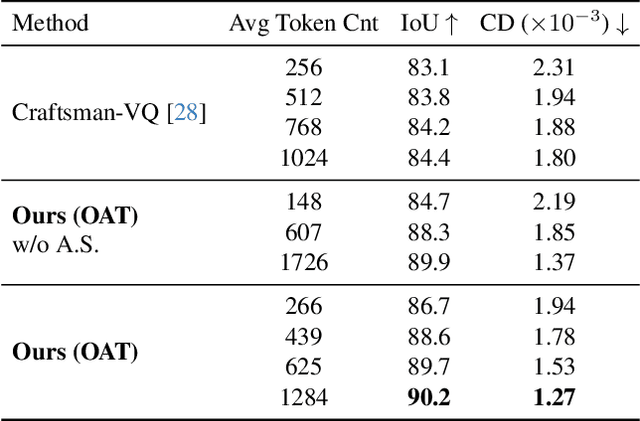
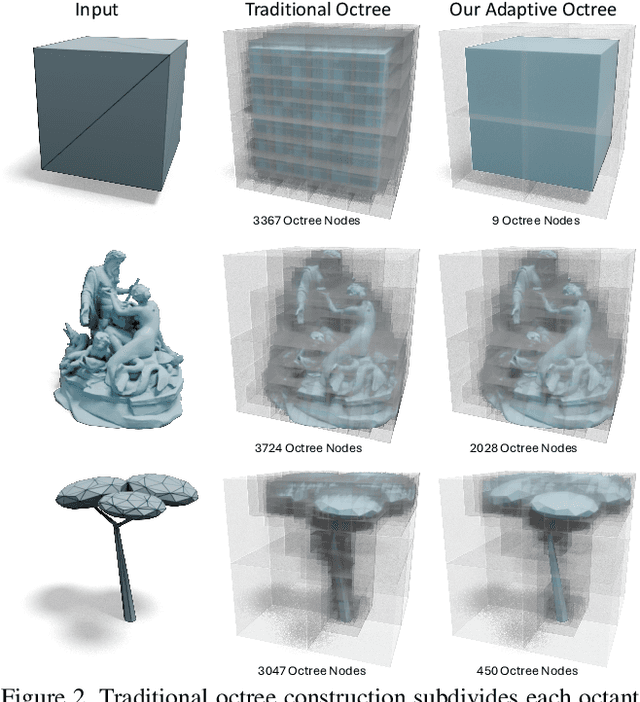
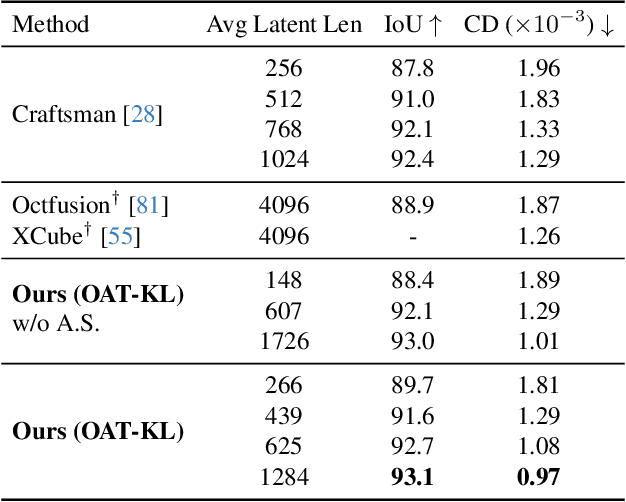

Abstract:Many 3D generative models rely on variational autoencoders (VAEs) to learn compact shape representations. However, existing methods encode all shapes into a fixed-size token, disregarding the inherent variations in scale and complexity across 3D data. This leads to inefficient latent representations that can compromise downstream generation. We address this challenge by introducing Octree-based Adaptive Tokenization, a novel framework that adjusts the dimension of latent representations according to shape complexity. Our approach constructs an adaptive octree structure guided by a quadric-error-based subdivision criterion and allocates a shape latent vector to each octree cell using a query-based transformer. Building upon this tokenization, we develop an octree-based autoregressive generative model that effectively leverages these variable-sized representations in shape generation. Extensive experiments demonstrate that our approach reduces token counts by 50% compared to fixed-size methods while maintaining comparable visual quality. When using a similar token length, our method produces significantly higher-quality shapes. When incorporated with our downstream generative model, our method creates more detailed and diverse 3D content than existing approaches.
Generating Multi-Image Synthetic Data for Text-to-Image Customization
Feb 03, 2025Abstract:Customization of text-to-image models enables users to insert custom concepts and generate the concepts in unseen settings. Existing methods either rely on costly test-time optimization or train encoders on single-image training datasets without multi-image supervision, leading to worse image quality. We propose a simple approach that addresses both limitations. We first leverage existing text-to-image models and 3D datasets to create a high-quality Synthetic Customization Dataset (SynCD) consisting of multiple images of the same object in different lighting, backgrounds, and poses. We then propose a new encoder architecture based on shared attention mechanisms that better incorporate fine-grained visual details from input images. Finally, we propose a new inference technique that mitigates overexposure issues during inference by normalizing the text and image guidance vectors. Through extensive experiments, we show that our model, trained on the synthetic dataset with the proposed encoder and inference algorithm, outperforms existing tuning-free methods on standard customization benchmarks.
Multi-subject Open-set Personalization in Video Generation
Jan 10, 2025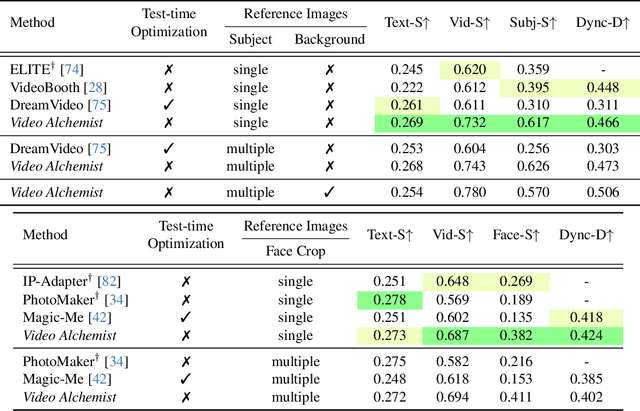
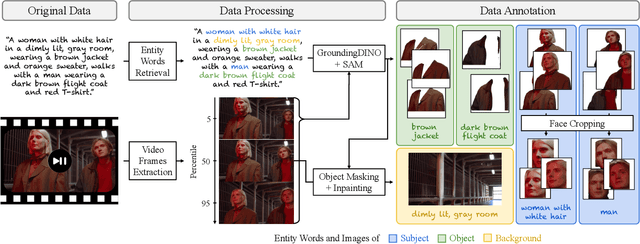

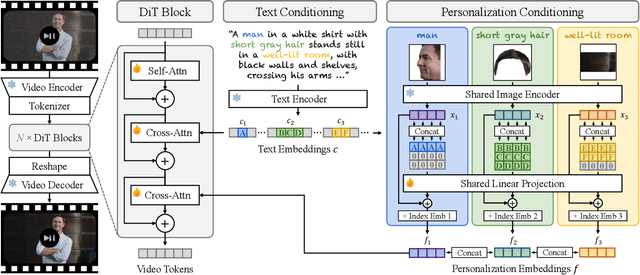
Abstract:Video personalization methods allow us to synthesize videos with specific concepts such as people, pets, and places. However, existing methods often focus on limited domains, require time-consuming optimization per subject, or support only a single subject. We present Video Alchemist $-$ a video model with built-in multi-subject, open-set personalization capabilities for both foreground objects and background, eliminating the need for time-consuming test-time optimization. Our model is built on a new Diffusion Transformer module that fuses each conditional reference image and its corresponding subject-level text prompt with cross-attention layers. Developing such a large model presents two main challenges: dataset and evaluation. First, as paired datasets of reference images and videos are extremely hard to collect, we sample selected video frames as reference images and synthesize a clip of the target video. However, while models can easily denoise training videos given reference frames, they fail to generalize to new contexts. To mitigate this issue, we design a new automatic data construction pipeline with extensive image augmentations. Second, evaluating open-set video personalization is a challenge in itself. To address this, we introduce a personalization benchmark that focuses on accurate subject fidelity and supports diverse personalization scenarios. Finally, our extensive experiments show that our method significantly outperforms existing personalization methods in both quantitative and qualitative evaluations.
Object-level Visual Prompts for Compositional Image Generation
Jan 02, 2025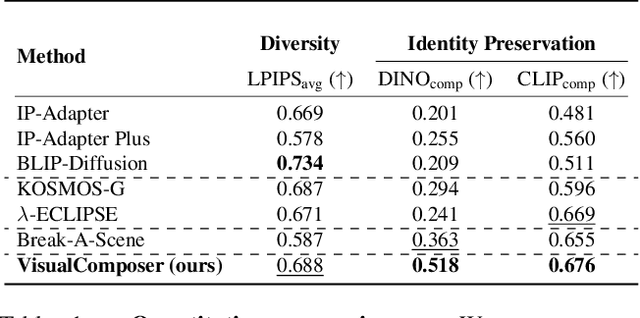
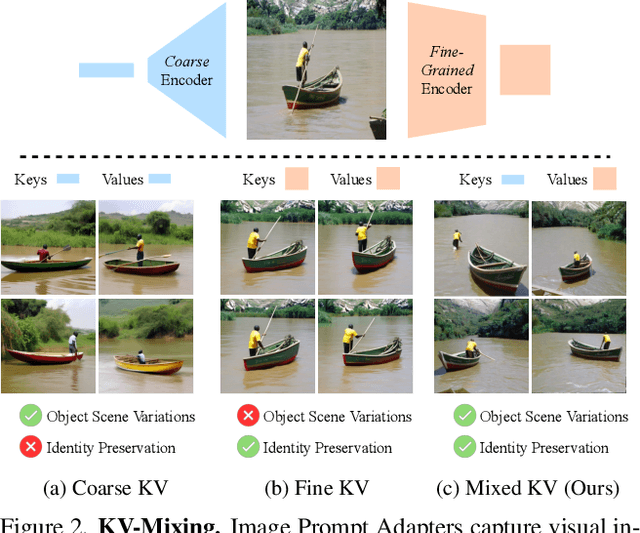
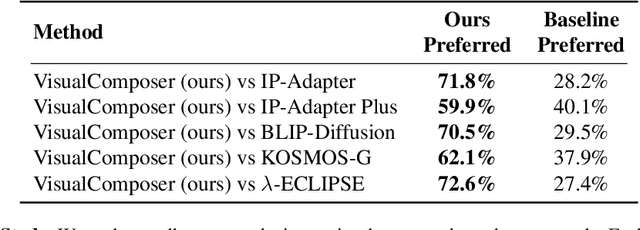
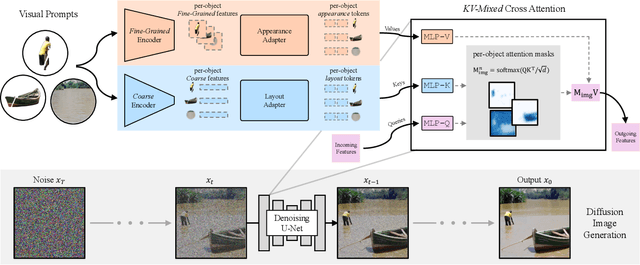
Abstract:We introduce a method for composing object-level visual prompts within a text-to-image diffusion model. Our approach addresses the task of generating semantically coherent compositions across diverse scenes and styles, similar to the versatility and expressiveness offered by text prompts. A key challenge in this task is to preserve the identity of the objects depicted in the input visual prompts, while also generating diverse compositions across different images. To address this challenge, we introduce a new KV-mixed cross-attention mechanism, in which keys and values are learned from distinct visual representations. The keys are derived from an encoder with a small bottleneck for layout control, whereas the values come from a larger bottleneck encoder that captures fine-grained appearance details. By mixing keys and values from these complementary sources, our model preserves the identity of the visual prompts while supporting flexible variations in object arrangement, pose, and composition. During inference, we further propose object-level compositional guidance to improve the method's identity preservation and layout correctness. Results show that our technique produces diverse scene compositions that preserve the unique characteristics of each visual prompt, expanding the creative potential of text-to-image generation.
Tactile DreamFusion: Exploiting Tactile Sensing for 3D Generation
Dec 09, 2024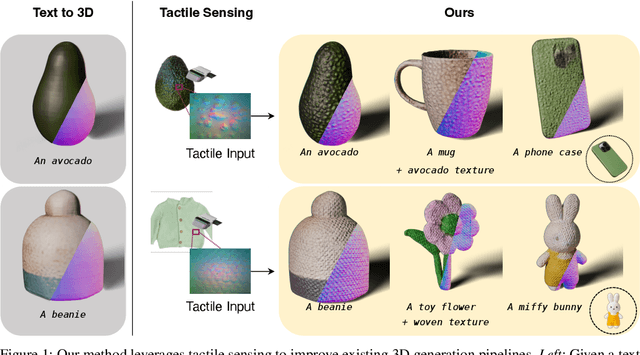
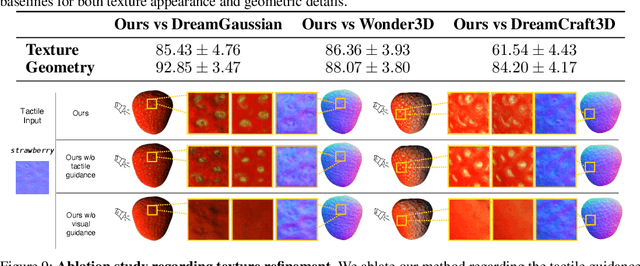

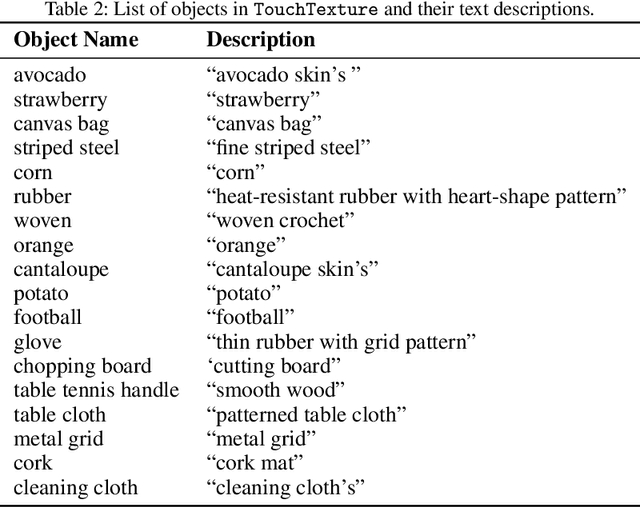
Abstract:3D generation methods have shown visually compelling results powered by diffusion image priors. However, they often fail to produce realistic geometric details, resulting in overly smooth surfaces or geometric details inaccurately baked in albedo maps. To address this, we introduce a new method that incorporates touch as an additional modality to improve the geometric details of generated 3D assets. We design a lightweight 3D texture field to synthesize visual and tactile textures, guided by 2D diffusion model priors on both visual and tactile domains. We condition the visual texture generation on high-resolution tactile normals and guide the patch-based tactile texture refinement with a customized TextureDreambooth. We further present a multi-part generation pipeline that enables us to synthesize different textures across various regions. To our knowledge, we are the first to leverage high-resolution tactile sensing to enhance geometric details for 3D generation tasks. We evaluate our method in both text-to-3D and image-to-3D settings. Our experiments demonstrate that our method provides customized and realistic fine geometric textures while maintaining accurate alignment between two modalities of vision and touch.
 Add to Chrome
Add to Chrome Add to Firefox
Add to Firefox Add to Edge
Add to Edge